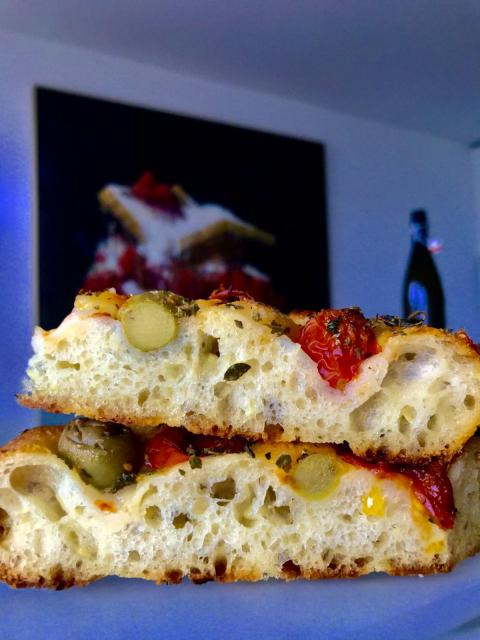
Focaccia Barese

FOCACCIA BARESE
Lately I’ve been obsessing over focaccia. Its one of those deceptive breads and its not until you taste an excellent one that you understand there is so much more to focaccia than meets the eye. So much that in Italy these breads are rarely made at home, generally focaccia is left to the professionals who have not just the know how but access to the best ingredients and really hot ovens. Focaccia takes patience, the best flour and absolutely the very best EVOO you can afford. It is an enriched dough after all, and it is the olive oil that makes all the difference. So use the good stuff and don’t be stingy! Click on any image to begin the slide show.






When it comes to Italian focaccia it is generally accepted there are two kinds worth knowing about. One from the north (Liguria), Focaccia Classica di Genova and the other from the south (Puglia), Focaccia Barese. I included a recipe for the Genovese version in my first book, Piano, Piano, Piano for any of you who might happen to have a copy of that book.
Focaccia Barese is made in and around the city of Bari in the region of Puglia. The authentic version uses lievito madre(sourdough) and is made with a combination of Tipo “0” and the semolata di grano rimacinata flour milled from sun kissed durum wheat grown in Puglia. The starter is a stiff one and should be refreshed 4 hours before being used. I used 100 grams of liquid levain, 100 grams of semolina flour and 50 grams water for that refreshment. The curious addition of boiled rice potato to the dough gives it an intriguing flavour and also enhances the shelf life. This focaccia keeps nicely for 2 or 3 days. The formula I used is the most official one I could find, from the facebook page of the Consorzio della Focaccia Barese. It makes two 32 cm (12 inch) round focacce but of course you could modify that to fit whatever baking pans you have.
 FOR THE DOUGH
FOR THE DOUGH- 200 grams stiff levain
- 300 grams tipo 0 Italian flour
- 200 grams semola di grano rimacinata
- 100 grams potato, boiled or steamed then riced or mashed and cooled
- 350 ml water
- 10 grams salt
- 50 grams EVOO
- cherry tomatoes
- olives
- oregano, more olive oil and salt
- The dough is mixed, divided in two, rounded and left to ferment at room temperature for 8 to 12 hours on a well oiled tray. Most of this oil will be absorbed by the dough during the fermentation period. Spread more oil over the top of the dough and cover with plastic wrap. After the dough has finished the fermentation generously oil 2-32 cm (12 inch) round baking pans and transfer the dough to the pans. Press the dough out to the edges of the pans using the tips of the fingers of both hands. Crush the cherry tomatoes in your hands over the dough and spread them evenly, place the olives and sprinkle the oregano oven the dough before drizzling more olive oil and sprinkling more salt. The dough is not given a final proof, it goes straight into the oven once it is shaped.
- Bake at 270 C or 550 F for 25 minutes.
- When it is finished baking and still hot brush it with even more EVOO!!
- you can retard half the dough to bake later for up to two days


Comments
...you can make this?!
Bookmarked ✔︎ for sure.
Grazie for posting this, Susan!
Tom
thanks Tom and enjoy!
David
Thank you David!
Is that really 400 grams cherry tomatoes, or maybe 40?
I know, it does seem like a lot. I used the Consorzio quantities but I've taken out the amounts now, thank you for pointing that out. As they say in Italy "Quanta Basta"....(as many as you need)